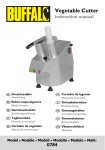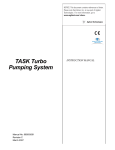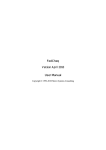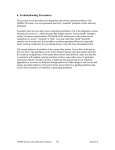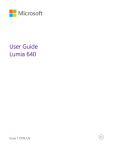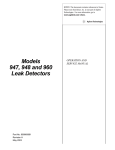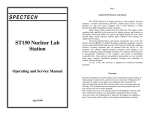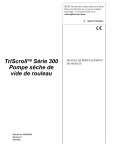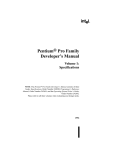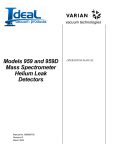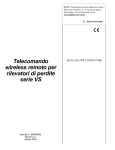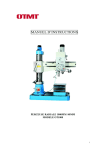Download senTorr™ Gauge Controller
Transcript
NOTICE: This document contains references to Varian. Please note that Varian, Inc. is now part of Agilent Technologies. For more information, go to www.agilent.com/chem. vacuum technologies senTorr™ Gauge Controller Manual No. 699908165 Revision K September 2008 INSTRUCTION MANUAL senTorr Gauge Controller Copyright 2008 Varian, Inc. senTorr Gauge Controller Warranty Products manufactured by Seller are warranted against defects in materials and workmanship for twelve (12) months from date of shipment thereof to Customer, and Seller’s liability under valid warranty claims is limited, at the option of Seller, to repair, to replace, or refund of an equitable portion of the purchase price of the Product. Items expendable in normal use are not covered by this warranty. All warranty replacement or repair of parts shall be limited to equipment malfunctions which, in the sole opinion of Seller, are due or traceable to defects in original materials or workmanship. All obligations of Seller under this warranty shall cease in the event of abuse, accident, alteration, misuse, or neglect of the equipment. In-warranty repaired or replaced parts are warranted only for the remaining unexpired portion of the original warranty period applicable to the repaired or replaced parts. After expiration of the applicable warranty period, Customer shall be charged at the then current prices for parts, labor, and transportation. Reasonable care must be used to avoid hazards. Seller expressly disclaims responsibility for loss or damage caused by use of its Products other than in accordance with proper operating procedures. Except as stated herein, Seller makes no warranty, express or implied (either in fact or by operation of law), statutory or otherwise; and, except as stated herein, Seller shall have no liability under any warranty, express or implied (either in fact or by operation of law), statutory or otherwise. Statements made by any person, including representatives of Seller, which are inconsistent or in conflict with the terms of this warranty shall not be binding upon Seller unless reduced to writing and approved by an officer of Seller. Warranty Replacement and Adjustment All claims under warranty must be made promptly after occurrence of circumstances giving rise thereto, and must be received within the applicable warranty period by Seller or its authorized representative. Such claims should include the Product serial number, the date of shipment, and a full description of the circumstances giving rise to the claim. Before any Products are returned for repair and/or adjustment, written authorization from Seller or its authorized representative for the return and instructions as to how and where these Products should be returned must be obtained. Any Product returned to Seller for examination shall be prepaid via the means of transportation indicated as acceptable by Seller. Seller reserves the right to reject any warranty claim not promptly reported and any warranty claim on any item that has been altered or has been returned by non-acceptable means of transportation. When any Product is returned for examination and inspection, or for any other reason, Customer shall be responsible for all damage resulting from improper packing or handling, and for loss in transit, notwithstanding any defect or non-conformity in the Product. In all cases, Seller has the sole responsibility for determining the cause and nature of failure, and Seller’s determination with regard thereto shall be final. If it is found that Seller’s Product has been returned without cause and is still serviceable, Customer will be notified and the Product returned at Customer’s expense; in addition, a charge for testing and examination may be made on Products so returned. 3/1/00 iii senTorr Gauge Controller This page intentionally left blank. senTorr Gauge Controller Contents Preface ............................................................................................................................................ xii Cleaning .................................................................................................................................... xiii Contacting Varian ...................................................................................................................... xiii Introduction and Installation ........................................................................................................ 1-1 Introduction ................................................................................................................................ 1-3 Front Panel............................................................................................................................ 1-3 Serial Communication........................................................................................................... 1-7 Battery Backup...................................................................................................................... 1-7 Installation .................................................................................................................................. 1-8 Unpacking ............................................................................................................................ 1-8 Setting Line Voltage, Installing Optional PCBs and Installing the Recorder Option ................ 1-8 Operating Instructions ................................................................................................................. 2-1 Parameter Programming.............................................................................................................. 2-1 Setpoint Hysteresis...................................................................................................................... 2-5 Recorder Output ......................................................................................................................... 2-6 Thermocouple and ConvecTorr Calibration ................................................................................ 2-9 Access Codes............................................................................................................................ 2-10 Software Revision ..................................................................................................................... 2-12 Display Test .............................................................................................................................. 2-12 Accessing Second Filament....................................................................................................... 2-12 Troubleshooting ............................................................................................................................ 3-1 Error Codes ................................................................................................................................. 3-1 Changing Line Fuses ................................................................................................................... 3-2 Application Footnotes ................................................................................................................. 3-3 Emission mA ......................................................................................................................... 3-3 Sensitivity.............................................................................................................................. 3-5 Troubleshooting Tips .................................................................................................................. 3-6 Appendix A. Gas Correction Factor Table ................................................................................. A-1 Appendix B. senTorr Gauge Specifications .............................................................................. B-1 General Specifications ................................................................................................................B-1 Cold Cathode Gauge.............................................................................................................B-2 Thermocouple and ConvecTorr Gauge .................................................................................B-3 Setpoints ...............................................................................................................................B-3 Remote Input ........................................................................................................................B-3 v senTorr Gauge Controller Appendix C. RS-232 and RS-485 Options ..................................................................................C-1 Board Configurations ..................................................................................................................C-1 RS–232 standard version.......................................................................................................C-1 RS–485 .................................................................................................................................C-1 Installation ..................................................................................................................................C-2 Operation ...................................................................................................................................C-6 Setting Baud Rate and Address ..............................................................................................C-6 Command Syntax and Definitions.........................................................................................C-7 Request for Return Health and Safety Certification vi senTorr Gauge Controller List of Tables Table Title 1-1 1-2 1-3 2-1 2-2 2-3 2-4 2-5 3-1 3-2 3-3 A-1 B-1 B-2 B-3 B-4 Gauge Configuration Key Entries.......................................................................................... 1-5 Keypad Functions ................................................................................................................ 1-6 Setpoint Option PCB Components ..................................................................................... 1-11 Setpoints .............................................................................................................................. 2-3 TC Linear Output ................................................................................................................. 2-8 UHV, BA and CC Linear Output .......................................................................................... 2-8 Full Scale Results ................................................................................................................. 2-8 Access Codes..................................................................................................................... 2-11 senTorr Gauge Error Codes .................................................................................................. 3-1 Emission Defaults................................................................................................................. 3-4 Sensitivity ............................................................................................................................ 3-5 Gas Correction Factor Table ............................................................................................... A-2 General senTorr Gauge Specifications ................................................................................ B-1 HFIG Gauge Specifications (Models: BA2, BA2C, BA, UHV, and UHV2C) ......................... B-2 Cold Cathode Gauge Specifications (Models: CC2 and CC2C)............................................ B-2 Thermocouple and ConvecTorr Gauge Specifications (Models: BA2, CC2, BA2C, CC2C, and UHV2C)................................................................. B-3 RS–485 Selection ................................................................................................................ C-3 RS–485 Terminating Resistance Selection ........................................................................... C-3 RS–232 Signal Communications ......................................................................................... C-4 RS–232 Null Modem or Standard Selection ........................................................................ C-4 RS–485 Signal Connections for Daisy Chaining .................................................................. C-5 Setpoint Numbering............................................................................................................ C-7 Serial Command Set ........................................................................................................... C-8 C-1 C-2 C-3 C-4 C-5 C-6 C-7 Page vii senTorr Gauge Controller This page intentionally left blank. senTorr Gauge Controller List of Figures Figure Caption 1-1 1-2 1-3 1-4 1-5 1-6 2-1 2-2 3-1 C-1 C-2 Page senTorr Gauge Controller Front Panel .................................................................................. 1-3 Setting Line Voltage ............................................................................................................. 1-9 Panel Cutout Dimensions................................................................................................... 1-10 Rear Panel Connections ..................................................................................................... 1-10 Setpoint Option ................................................................................................................. 1-11 Assembling the Cable ........................................................................................................ 1-12 Standard Recorder Output Characteristics............................................................................ 2-7 Optional Linear Recorder Output Characteristics ................................................................. 2-7 Power Entry Module ............................................................................................................ 3-2 Installing the Serial Communication Board ..........................................................................C-2 Pin Connections...................................................................................................................C-5 ix senTorr Gauge Controller This page intentionally left blank. Declaration of Conformity Konformitätserklärung Déclaration de Conformité Declaración de Conformidad Verklaring de Overeenstemming Dichiarazione di Conformità We Wir Nous Nosotros Wij Noi Varian, Inc. 121 Hartwell Avenue Lexington, MA, 02421-3133 USA declare under our sole responsibility that the product, erklären, in alleniniger Verantwortung, daß dieses Produkt, déclarons sous notre seule responsabilité que le produit, declaramos, bajo nuestra sola responsabilidad, que el producto, verklaren onder onze verantwoordelijkheid, dat het product, dichiariamo sotto nostra unica responsabilità, che il prodotto, senTorr Gauge Controller to which this declaration relates is in conformity with the following standard(s) or other normative documents. auf das sich diese Erklärung bezieht, mit der/den flogenden Norm(en) oder Richtlinie(n) übereinstimmt. auquel se réfère cette déclaration est conforme à la (auz) norme(s) ou au(x) document(s) normatif(s). al que se refiere esta declaración es conforme a la(s) norma(s) u otro(s) documento(s) normativo(s). waamaar deze verklaring verwijst, aan de volende norm(en) of richtlijn(en) beantwoodt. a cui se rifersce questa dichiarazione è conforme alla/e sequente/I norma/o documento/I normativo/i. EN 55011 1991 . . . . . . . . . . . . . . . . . . . . . . . . Group 1 Class A ISM emission requirements EN 61010-1 1993 . . . . . . . . . . . . . . . . . . . . . . . . Safety requirements for electrical equipment for measurement, control, and laboratory use incorporating Amendments Nos 1 and 2. EN 50082-2 1995 . . . . . . . . . . . . . . . . . . . . . . . . EMC heavy industrial generic immunity standard Frederick C. Campbell Operations Manager Varian, Inc. Lexington, Massachusetts, USA October 2003 senTorr Gauge Controller Preface Hazard and Safety Information This manual uses the following standard safety protocols: WARNING The warning messages are for attracting the attention of the operator to a particular procedure or practice which, if not followed correctly, could lead to serious injury. CAUTION The caution messages are displayed before procedures, which if not followed, could cause damage to the equipment. NOTE The notes contain important information. This product must only be operated and maintained by trained personnel. Before operating or servicing equipment, read and thoroughly understand all operation/ maintenance manuals provided by Varian. Be aware of the hazards associated with this equipment, know how to recognize potentially hazardous conditions, and how to avoid them. Read carefully and strictly observe all cautions and warnings. The consequences of unskilled, improper, or careless operation of the equipment can be serious. In addition, consult local, state, and national agencies regarding specific requirements and regulations. Address any safety, operation, and/or maintenance questions to your nearest Varian office. xii senTorr Gauge Controller EMC Warnings EN 55022 Class A Warning This is a Class A product. In a domestic environment this product may cause radio interference in which case the user may be required to take adequate measures. FCC This device complies with Part 15 of the FCC rules. Operation is subject to the following two conditions: (1) This device may not cause harmful interference, and (2) this device must accept any interference received, including interference that may cause undesirable operation. NOTE The equipment has been tested and found to comply with the limits for a Class A digital device, pursuant to Part 15 of the FCC rules. These limits are designed to provide reasonable protection against harmful interference when the equipment is operated in a commercial environment. This equipment generated, uses, and can radiate radio frequency energy and, if not installed and used in accordance with the instruction manual, may cause harmful interference to radio communications. Operation of this equipment in a residential area is also likely to cause harmful radio communications interference in which case the user will be required to correct the interference at his own expense. Cleaning Clean the unit using a clean, slightly damp cloth. Do not use solvents or sprays. Contacting Varian In the United States, you can contact Varian Customer Service at 1-800-8VARIAN. Internet users: ❑ Send email to Customer Service & Technical Support at [email protected] ❑ Visit our web site at www.varianinc.com/vacuum ❑ Order on line at www.evarian.com See the back cover of this manual for a listing of our sales and service offices. xiii senTorr Gauge Controller This page intentionally left blank. senTorr Gauge Controller Introduction and Installation This chapter introduces the senTorr, including: ❑ “Introduction” on page 1-3 ❑ “Serial Communication” on page 1-7 ❑ “Battery Backup” on page 1-7 This chapter also describes “Setting Line Voltage, Installing Optional PCBs and Installing the Recorder Option” on page 1-8. Varian senTorr Gauge Controller is a complete, half-rack vacuum gauge controller that offers continuous, reliable pressure measurement from rough to high vacuum. The controller comes completely configured from the factory to operate one of eight gauge tube configurations: ❑ UHV2C – Two ConvecTorrs and one UHV type HFIG ❑ BA2 – Two Thermocouples and one Bayard-Alpert gauge tube ❑ BA2C – Two ConvecTorrs and one Bayard-Alpert gauge tube ❑ CC2 – Two Thermocouples and one Cold Cathode gauge tube ❑ CC2C – Two ConvecTorrs and one cold cathode gauge tube ❑ BA – One Bayard-Alpert gauge tube ❑ CC – One Cold Cathode gauge tube ❑ UHV – One UHV type HFIG The senTorr Gauge Controller features one digital display per gauge tube. These LED displays provide clear and sharp pressure readings. The front panel keypad has practical lockout features that protect against unauthorized parameter inputs. Analog outputs and remote capabilities are located on the back panel. The optically-isolated and floating level-sensitive external remote input controls turn on and off the high-vacuum gauge emission. 1-1 senTorr Gauge Controller The available options include: UHV and Bayard-Alpert Configurations Up to three optional plug-in printed circuit boards can be installed in the UHV, UHV2C, BA2, BA2C, and BA configurations, with the following restrictions: ❑ One Setpoint board (four setpoints, one for each gauge tube plus an additional setpoint assignable to any one of the three gauge tubes), ❑ One degas board (resistive I2R degas) (BA2s are resistive degas (UHV E-beam) ❑ One communications board (either RS232 or RS485) Cold Cathode Configurations Up to two optional plug-in printed circuit boards can be installed in the CC2, CC2C, and CC configurations, with the following restrictions: ❑ One Setpoint board (four setpoints, one for each gauge tube plus an additional setpoint assignable to any one of the three gauge tubes) ❑ And one communications board (either RS232 or RS485) 1-2 senTorr Gauge Controller Introduction Front Panel Figure 1-1 shows the front panel keys and display features. Following each key name are the senTorr models and the option, if any, to which the function applies. Some keys may not work unless a particular option has been installed. LED Annunciators Red LEDs (Operational states) Operation keys Figure 1-1 senTorr Gauge Controller Front Panel 1-3 senTorr Gauge Controller Refer to Table 1-2 on page 1-6 for descriptions of the keypad items. The front panel display of the senTorr consists of 7-segment LED digits and LED annunciators. These provide continuous, crisp readings, with no directional bias. The display uses three LED colors to group information: Green Pressure data and parameter values Yellow Setpoint and parameter annunciators Red Operational status legends A single pressure display has four digits: two for the mantissa and two for the exponent. The following appear, as applicable: Label Pressure IG UHV or Bayard-Alpert or Cold Cathode (depending on the model) TC1 Thermocouple one or ConvecTorr one TC2 Thermocouple two or ConvecTorr two The column of red LEDs indicate the following operational states: 1-4 Degas UHV BA ion gauge is degassing EMIS On Ion gauge is on Auto-On Auto-on feature is programmed mbar Pressure measurements units are in mbar (Pascal if LED not illuminated) Torr Pressure measurement units are in Torr (Pascal if LED not illuminated) Cal Thermocouples or ConvecTorrs are calibrating Hyst Setpoint hysteresis is programmed or not in default senTorr Gauge Controller The keypad is a sealed membrane-type, with tactile feedback. There are eleven keys, some of which have dual functions. To determine the order number, select the desired configuration as shown in Table 1-1. Table 1-1 Gauge Configuration Key Entries Configuration Key Entry One Ion Gauge BA – Bayard-Alpert (563, 564, 571, 572) L9120301XX0X CC – Standard Cold Cathode (525) L9121301XX0X UHV – Ultra-High-Vacuum Nude Gauge (UHV-24, MBA100, MBA200) L9110301XX0X One Ion Gauge, Two Thermocouple Gauges BA2 L9120302XX0X CC2 L9121302XX0X One Ion Gauge, Two ConvecTorr Gauges BA2C L9120303XX0X CC2C L9121303XX0X UHV2C L9110303XX0X Setpoint Options No Setpoints 0 Setpoints 1 Degas Options No Degas 0 Degas (BA resistive, UHV E-Beam) 1 Communications Options No Communications 0 RS-232 1 RS-485 4 1-5 senTorr Gauge Controller Keypad Table 1-2 describes the keypad items shown in Figure 1-1 on page 1-3. Table 1-2 Key All Models Option Select Keypad Functions Function Puts the senTorr into the Program mode, as indicated by the flashing yellow annunciator. Repeated single presses step the annunciator through the column of setpoints and parameters, returning the senTorr to Run mode after the last key press. ❑ Press Option Select and then Enter to cancel storing a new digit setting. See “Parameter Programming” on page 2-1. for further information. Enter Advances the flashing cursor through a selected Program mode. Press Enter after the last digit to save the setting. UP Arrow DOWN Arrow Increments and decrements, respectively, digit values when entering data. Stdby Powers off the display and the ion gauge tube. This is considered a low power shutdown. The unit continues to provide power to the processor. Units Toggles the pressure measurement units between Torr, mbar and Pascal for all pressure readings. The front panel reflects the pressure units, with both the Torr and mbar lamps extinguished for Pascal. BA2 BA2C UHV2C CC2 CC2C Cal Calibrates the vacuum and atmosphere readings for the thermocouple gauges. Cal illuminates red when calibrating the thermocouples or ConvecTorrs. All Models with Setpoint option Stpt Hyst Displays or programs the setpoint hysteresis values when used in conjunction with the Option Select program mode. Hyst illuminates red to indicate that the setpoint pressure shown is the hysteresis level. See “Setpoint Hysteresis” on page 2-5. All Models Emis Turns the high vacuum gauge on or off. The hidden Emis On legend illuminates to reflect the on state of the ion emissions. The high vacuum gauge emissions comes on only if the appropriate vacuum has been achieved. For BA/UHV dual filament models: Press Enter and then press Emis to use the second filament. 1-6 senTorr Gauge Controller Table 1-2 Keypad Functions (Continued) Key All Models Baud Rate BA, Degas UHV Models with degas option Function Displays and sets the serial communications baud rate, parity, and the controller address used in a multi-drop communication link. See Appendix C “RS-232 and RS-485 Options” on page C-1. Illuminates the hidden degas legend to show the state of the degas. ❑ Press Degas to turn the degas function off. The degas automatically turns off after engagement. ❑ ❑ For I2R degas, turns off after approximately 1 hour. For E-beam, turns off after 15 minutes. The degas option must be installed. Active only if the pressure at the Bayard-Alpert ion gauge is less than 10−5 Torr. Serial Communication The senTorr can be operated remotely via a serial link. The RS232 option consists of a plug-in printed circuit board (Varian part no. L9141301) available with either a 9-pin, D-subminiature connector. All of the keypad functions, except for the baud rate settings and the display output, are accessible through the RS232 bidirectional computer link. The RS485/422 PCB option (Varian part no. L91433010) provides serial communications capability as specified in EIA standard 422 and 485. Both employ differential line drivers and receivers, and are capable of communicating to distances of 4000’ (1219.2m) at 19,200 baud in a multidrop scheme, with up to 32 senTorr units. Refer to Varian manual 6999-08-170, provided with the serial communication option, for further information. Battery Backup The senTorr uses a lithium battery and CMOS RAM for storage of all system parameters during power outages or when powered down. On power up, the senTorr verifies the RAM content. If the RAM is good, the parameters remains as previously saved; if the RAM is corrupted, all parameters are reset to their default values. 1-7 senTorr Gauge Controller Installation NOTE ❑ Use a braided -shield cable for the analog outputs and setpoint wiring. ❑ Connect metal or metallized plastic backshells directly to the cable shield at the 9-position D-sub connector, if using serial communications. ❑ Connect the shields of all I/O cables to the ground at the users equipment. ❑ Do not block ventilation openings on either side of the unit. Provide at least ¾" (19 mm) of free air space on each side of the unit. Installation consists of: ❑ “Unpacking” ❑ “Setting Line Voltage, Installing Optional PCBs and Installing the Recorder Option” Unpacking Each senTorr unit is inspected and carefully packed prior to shipment. If the unit arrives damaged, save the packing material and immediately notify the carrier. Because the packing materials are designed specifically for this instrument, always reuse them when transporting the unit. The shipping container is packed with: ❑ 1 senTorr Basic Unit ❑ 1 AC line cord ❑ 1 Instruction Manual ❑ 4 rubber adhesive feet for bench top use of the senTorr Setting Line Voltage, Installing Optional PCBs and Installing the Recorder Option This section consists of: ❑ “Setting the Line Voltage” on page 1-9 ❑ “Installing the Setpoint Relays” on page 1-11 ❑ “Installing the Recorder” on page 1-12 1-8 senTorr Gauge Controller Setting the Line Voltage NOTE The unit is shipped with switch S1 (internal) set to 230 VAC. WARNING Before servicing the unit, check that the line cord is not plugged into a power source. Observe all warnings and cautions printed on the cover. Before operating the unit, it is necessary to set it for the proper line voltage level. To set the line voltage: 1. Remove the two screws at the top rear of the unit, pivot the cover up and back to disengage the front lip, and lift off the cover. 2. Set the line voltage by moving line voltage selector switch S1 (Figure 1-2) to either: ❑ For 110 VAC or 115 VAC, 50/60 Hz Set to 115 VAC ❑ For 220 VAC or 240 VAC, 50/60 Hz Set to 230 VAC Figure 1-2 Setting Line Voltage 3. Ensure that: ❑ All cables are properly plugged in ❑ All hardware inside the senTorr unit is properly connected ❑ No loose metal parts inside the senTorr unit 4. Replace the cover and secure it with the two screws. 1-9 senTorr Gauge Controller 5. Mount the unit using the desired rack-mounting kit (Figure 1-3). Figure 1-3 NOTE Panel Cutout Dimensions See Table B-1 on page B-1 for ventilation requirements. 6. Attach the appropriate external gauge and system cables (Figure 1-4). Figure 1-4 NOTE 1-10 Rear Panel Connections Use Bezel Trim Kit (Varian part number R0130301) to hide gaps between senTorr case and panel. senTorr Gauge Controller Installing the Setpoint Relays CAUTION The relay contacts are gold-flashed, making them suitable for logic-level switching. The application of AC or DC voltages, however, greater than 20 V (3 A @ 24 VDC/250 VAC) or 20 VA causes erosion of the gold in a single switching cycle. Refer to Table 1-3 and Figure 1-5 to install the setpoint option. Table 1-3 Setpoint Option PCB Components Number In Figure Description 1 Setpoint Assembly (Part number L9132002) 2 Bracket 3 Screw 4 Cable 5 Connector Mate Figure 1-5 Setpoint Option 1-11 senTorr Gauge Controller To install the Setpoint option: 1. Punch out the metal panel on the back of the unit. 2. Lower the Setpoint Assembly PCB into the senTorr and hold. 3. Place and tighten two screw (item 3) through the plate on the right side of the senTorr and the Setpoint Assembly PCB mounting flanges (item 2) and tighten. 4. Connect the ribbon cable to J4 and ensure it is connected to J2 on the Setpoint Assembly PCB. 5. Install the connector mate to the connects on the Setpoint board (item 5). Installing the Recorder Recorder output for each gauge is provided at the back of the unit. A two-conductor Micro Jax connector is plugged into each output. Shielded wiring (coaxial cable) is strongly recommended to maintain compliance with FCC regulations for radiated emissions. Any recorder with an input impedance greater than 2,000 Ohms and a full scale input range of +10 V can be used. Refer to Figure 1-6 for instructions on installing the recorder. 1. Strip to 0.1" of bar wire. 3. Solder the center conductor. 0.1" 2. Strip the outer cover 0.2". 4. Crimp the tabs onto the shield and solder. 0.2" Figure 1-6 1-12 Assembling the Cable senTorr Gauge Controller Operating Instructions Operations consist of: ❑ “Parameter Programming” ❑ “Setpoint Hysteresis” on page 2-5 ❑ “Recorder Output” on page 2-6 ❑ “Thermocouple and ConvecTorr Calibration” on page 2-9 ❑ “Access Codes” on page 2-10 ❑ “Software Revision” on page 2-12 ❑ “Display Test” on page 2-12 ❑ “Accessing Second Filament” on page 2-12 Parameter Programming The setpoint and ion gauge parameters shown in a column on the front panel are viewed or programmed by putting the senTorr into the Program mode. To the left of each parameter is a single yellow LED. If the yellow LED is: ❑ Flashing The selected parameter is in Program mode and its value appears in the corresponding gauge readout. ❑ Illuminated solidly The selected menu item is active, indicating that the setpoint is energized or the ion gauge parameter has been changed from its default setting. NOTE If the ion gauge is on when power is lost, emission is not automatically reestablished unless the TC Auto-On function is programmed to do so. 2-1 senTorr Gauge Controller To enter Program mode: NOTE The senTorr exits the Program mode if no keys are pressed for about eight seconds. 1. Press Option Select. The first available parameter, beginning from the top of the column and depending on the senTorr models and options installed, flashes in the appropriate gauge display. 2. Press Option Select to advance to the desired parameter. NOTE Option Select returns the unit to the Run mode after the last parameter is selected. 3. Use the up and down arrow keys to set a new value. 4. Press Enter to advance to the next digit. 5. Use the up and down arrow keys to set a new value for each digit as required. 6. Press Enter until the last digit for the parameter is passed. NOTE No individual digit for a parameter is saved until all digits of that parameter have been passed through using Enter. Then the entire parameter value is saved. Use Option Select to escape from saving a changed value prior to entering the last digit. If the yellow LED remains flashing in the Program mode unattended for more than eight seconds, the annunciator automatically returns to Run mode. After the value has been saved, the whole setting flashes. ❑ To disable a setpoint, Set its mantissa to 0.0. 2-2 senTorr Gauge Controller Table 2-1 lists the setpoints and their functions. Table 2-1 Setpoint Setpoints Function All Models with Setpoint option IG Setpt Sets the ion gauge setpoint to energize when the ion gauge pressure drops below the IG Setpt threshold setting. It de-energizes when the ion gauge pressure goes above the IG Setpt hysteresis setting (See “Setpoint Hysteresis” on page 2-5). The IG Setpt pressure flashes in the IG display. All Models with Setpoint option TC1 Setpt Sets the TC1 setpoint to energize when TC1 reads less than the TC1 Setpt threshold setting. It de-energizes when the TC1 pressure goes above the TC1 Setpt hysteresis setting (See “Setpoint Hysteresis” on page 2-5). The TC1 Setpt pressure appears in the TC1 readout. All models with TC2 Setpt TC or ConvecTorr with Setpoint option Sets the TC2 setpoint to energize when TC2 reads less than the TC2 Setpt threshold setting. It de-energizes when the TC2 pressure goes above the TC2 Setpt hysteresis setting (See “Setpoint Hysteresis” on page 2-5). The TC2 Setpt pressure appears in the TC2 readout. All Models with Setpoint option Add’l Setpt Assigns the additional setpoint to any of the gauges: BA2 BA2C CC2 CC2C Auto–On UHV2C 1. 2. 3. 4. Select this parameter. All three pressure displays flash. Press Enter to assign the Add’l Setpt to the ion gauge. Ensure no value is set in the ion gauge display: mantissa = 0.0. Press Enter again to assign the Add’l Setpt to TC1, or likewise to TC2. Assigns TC1 as the turn-on source for the ion gauge: 1. Press Option Select until the Auto-On Setpt annunciator flashes. The Auto-On setting then appears in the TC1 readout. 2. Set the turn-on pressure from 1.0 x 10−3 Torr to 5.0 x 10-3 Torr (1.3 x 10-2 Pa to 6.6 x 10-1 Pa) and additionally between 1.0 x 10-2 Torr to 5.0 x 10-2 Torr (1.3 Pa to 6.6 Pa). The ion gauge turns on when TC1 reaches the programmed pressure. Press Emis to turn the ion gauge off and temporarily override the Auto-On feature. The Auto-On feature goes back into effect after the TC1 pressure rises above the programmed Auto-On pressure. 2-3 senTorr Gauge Controller Table 2-1 Setpoints (Continued) Setpoint BA2 Controls the hot filament gauge emission current. The programmed value flashes in the IG display: BA2C ❑ Select a value from 0.1 mA to 9.9 mA. BA Emis mA Function The default setting is 4 mA for standard gauges and 0.1 mA for broad range Bayard-Alpert gauges (Varian model 564). If the emission current is set to: UHV UHV2C ❑ Less than or equal to 1.0 mA, it remains constant over all pressures. ❑ Greater than 1.0 mA, it is automatically reduced to one-tenth of the setting at pressures greater than 5 x 10-5 Torr (6.6 x 10-2 Pa). This feature extends filament life. All Models Ion Sens Compensates for the different gauge geometries. The current setting flashes in the IG display. Refer to Table B-1 on page B-1 for the default sensitivity settings. All Models GasCorr Adjusts the ion gauge pressure calculation depending on the system gas. The gas correction value appears in the IG readout. The default setting is 1.0 for N2 (air). The setting can range from 0.1 to 9.9. Refer to Appendix A “Gas Correction Factor Table”. 2-4 senTorr Gauge Controller Setpoint Hysteresis A setpoint: ❑ Energizes when the pressure of its preassigned gauge drops below the setpoint programmed threshold pressure. ❑ De-energizes when the gauge pressure rises above the setpoint hysteresis pressure. The setpoint hysteresis automatically defaults to 10% above the threshold value. This value can be changed by pressing the Stpt Hyst key. The red Hyst legend illuminates to indicate that the setpoint pressure shown is the hysteresis level. NOTE The Stpt Hyst key does not function if the setpoint has not been programmed. 2-5 senTorr Gauge Controller Recorder Output The output reflects the displayed pressure of the gauges. Refer to Figure 2-1 and Figure 2-2 on page 2-7 and Table 2-2 on page 2-8 through Table 2-4 on page 2-8 for standard and linear output characteristics of the recorders. The following algorithms are used: Ion Gauge Algorithm To convert recorder output voltage to pressure: Example recorder output = 4.28 VDC To get the exponent, take the integer part of voltage output which is 4 and subtract 11: 4 – 11 = –7 (E–7) To find the mantissa, take the fractional portion and add .1 to it and divide by .11: (.28 + .1)/.11 = 3.45 Therefore: 4.28 VDC = 3.45E–7 Torr TC ConvecTorr Algorithm To convert recorder output voltage to pressure: Example recorder output = 3.28 VDC To get the exponent, take the integer part of voltage output which is 3 and subtract 4: 3 – 4 = –1 (E–1) To find the mantissa, take the fractional portion, add .1 to it, and divide by .11: (.28 + .1)/.11 = 3.45 Therefore: 3.28 VDC = 3.45E–1 Torr 2-6 senTorr Gauge Controller Figure 2-1 Figure 2-2 Standard Recorder Output Characteristics Optional Linear Recorder Output Characteristics 2-7 senTorr Gauge Controller Table 2-2 lists the optional linear recorder output for the TC configuration, which requires optionally purchased firmware. Table 2-2 TC Linear Output Pressure (Torr) Pressure (Pa) Voltage ≥1E +0 ≥133 10 1E–1 1.3 E1 1 5E–2 6.6 0.5 1E–2 1.3 0.1 ≥E–3 ≥.3E–1 0.01 Error E03 Error E03 10.156 (over scale) Table 2-3 lists the optional linear recorder output option for the UHV, BA and CC configurations. Table 2-3 UHV, BA and CC Linear Output Full Scale Setting (Torr) Full Scale Setting (Pa) Access Code 1E–3 1.3E–1 93 (Default) 1E–4 1.3E–2 94 1E–5 1.3E–3 95 1E–6 1.3E–4 96 Table 2-4 lists the results using a full scale setting of 1E–3 Torr as an example. Table 2-4 2-8 Full Scale Results Pressure (Torr) Pressure (Pa) Voltage ≥1E –3 ≥1.3E–1 10 1E–4 1.3E–2 1 5E–5 6.6E–3 0.5 1E–5 1.3E–3 0.1 ≥E–6 ≥.3E–4 0.01 Exx/Off Exx/Off 0 senTorr Gauge Controller Thermocouple and ConvecTorr Calibration The calibration is a two-point calibration, with one point at atmosphere and the second point at vacuum. Perform calibration: ❑ Before using the senTorr for the first time ❑ After the unit has been reset ❑ After the transducer has been changed ❑ If the display drifts ❑ If calibration values are off at atmosphere or vacuum Atmosphere Calibration Procedure You can calibrate individual transducers or both at once: 1. Ensure your transducer is at atmosphere. 2. To calibrate transducers: ❑ Individually a. Press Cal and the transducer 1 display flashes 7.6+2. b. Press Enter and 7.6+2 appears on the transducers display. c. Press Cal twice and the transducer 2 display flashes 7.6+2. d. Press Enter and 7.6+2 appears on the transducers display. ❑ Simultaneously a. Press Cal and the transducer 1 display flashes 7.6+2. b. Press Enter and 7.6+2 appears on the transducer 2 display. c. Press Enter and 7.6+2 appears on both displays. 2-9 senTorr Gauge Controller Vacuum Calibration Procedure 1. Ensure your transducer is evacuated down to 1.0 E-4. 2. To calibrate transducers: ❑ Individually a. Press Cal and the transducer 1 display flashes 1.0-3. b. Press Enter and 1.0-3 appears on the transducers display. c. Press Cal twice and the transducer 2 display flashes 1.0-3. d. Press Enter and 1.0-3 appears on the transducers display. ❑ Simultaneously a. Press Cal and the transducer 1 display flashes 1.0-3. b. Press Enter and 1.0-3 appears on the transducer 2 display. c. Press Enter and 1.0-3 appears on both displays. Access Codes The senTorr offers protection for the operator and the system by requiring that the operator know the access code for a desired function. To enter an access code: 1. Press Enter and then Units. 2. Use the up and down keys to select the appropriate two-digit code, shown in the IG readout. Table 2-5 lists the codes and their respective functions. 2-10 senTorr Gauge Controller Table 2-5 Code Access Codes Function 33 A Unlocks the keypad (default). 27 A Locks the keypad, except for the Enter, Units, and arrow keys to allow further access code entry. 17 A Locks the keypad, except for the Enter, Units, arrow, Emis, and Degas keys to prevent parameter changes. 81 A Resets the total system. All parameters except the baud rate settings revert to defaults. The ion gauge turns off. 71 A Resets TC calibrations to system defaults. 61 A Removes all setpoint programming. 39 A Sets Bayard-Alpert parameters to default Bayard-Alpert values: sensitivity, emission current, and overpressure shutdown. 49 A Sets Bayard-Alpert parameters to broad range Bayard-Alpert values (Varian Model 564): sensitivity, emission current, and overpressure shutdown. 79 A Sets thermocouple or ConvecTorr pressure update to slow, allowing more stable readings through data averaging (default). 89 A Sets thermocouple or ConvecTorr pressure update to fast, allowing a faster response to pressure changes. 56 A Enables E02 (pressure burst) and E06 (grid error) fault protection. 52 A Disables E02 (pressure burst) and E06 (grid error) fault protection. The senTorr overrides these faults for systems that are able to handle pressure spikes. 2-11 senTorr Gauge Controller Software Revision ❑ To display the software revision, press Enter, then the down arrow. The revision appears in the IG display for several seconds. Display Test ❑ To verify LED function, press Enter and the up arrow and the entire display can be lit for several seconds. Accessing Second Filament See Table 1-2 on page 1-6, EMIS Key for controlling dual filament tubes. 2-12 senTorr Gauge Controller Troubleshooting These troubleshooting procedures are provided to aid in identifying failure modes. For further troubleshooting assistance or for the repair or replacement of a board, contact Varian service at 1-800-882-7426 or 781-861-7200 within the U.S. This section is comprised of: ❑ “Error Codes” ❑ “Changing Line Fuses” on page 3-2 ❑ “Application Footnotes” on page 3-3 ❑ “Troubleshooting Tips” on page 3-6 Error Codes Table 3-1 lists the senTorr Gauge error codes: Table 3-1 Code senTorr Gauge Error Codes Error Condition O2 E Pressure burst caused by a sudden rise in pressure at the ion gauge. O3 E No ion current or measurement signal. Examples: bad or missing collector cable connection; bad electrometer; emission current too low; cold cathode pressure less than minimum pressure capability. See Appendix B “senTorr Gauge Specifications”. O4 E Filament overcurrent caused by a shorted filament circuit. O5 E Filament undercurrent caused by an open filament; cable not properly connected; bad control circuit or control circuit not properly installed. O6 E Grid voltage low caused by a grounded grid or a bad grid supply. O7 E Overtemperature caused by a temperature inside unit over 65° C. O8 E Board logic failure caused by a bad component or electrical noise. O9 E Overpressure caused by an indicated pressure above high pressure limit of the ion gauge. 12 E Underpressure caused by an indicated pressure beyond minimum pressure of ion gauge. 13 E Insufficient current caused by a dirty cold cathode gauge or an open cable connection. 14 E Invalid keypress caused by a locked keypad. 3-1 senTorr Gauge Controller Changing Line Fuses Due to age or overload, It become necessary to change the AC line fuses. There are two fuses located on the top of the power entry module marked with the outline of the fuses. To change a fuse: 1. Remove the power cable. 2. Pry out the cover of the fuse holder with a small screwdriver. 3. Slide the small fuse board out of the holder by lifting the black plastic retainer (Figure 3-1). Figure 3-1 NOTE Power Entry Module For continued protection against fire, both fuses must be replaced with fuses of the same type and rating as originally supplied: T, 5A, 250 V. 4. Replace the fuses. 5. Replace the cover and plug in the unit. 3-2 senTorr Gauge Controller Application Footnotes This section contains the following application notes: ❑ “Emission mA” ❑ “Sensitivity” on page 3-5 Emission mA The Emission current is set to 4.00 mA as a default. The emission current remains constant, at 4 mA, as long as the pressure is less than 1 x 10-5 Torr/1.3 x 10-3 Pa. The senTorr automatically reduces the current by a factor of 10 when the pressure is greater than 5 x 10-5 Torr/6.6 x 10-3 Pa. Thus, the emission current drops to 0.4 mA. This promotes an extended pressure range measurement capability and/or prolongs tube life by protecting the filament. Emission current can, however, be adjusted from 10 µA to 9.99 mA via the keypad on the front panel of the senTorr unit. One reason for lowering the emission current is to prevent a small fluctuation in a pressure reading that can occur when operating: ❑ just below 1 x 10-5 Torr/1.3 x 10-3 Pa ❑ just above 5 x 10-5 Torr/6.6 x 10-3 Pa If emission current is adjusted to <1 mA, the current remains constant throughout the entire pressure range. Another reason to lower the emission current is for applications that require higher pressure readings from the gauge tube. The lower the emission current, the higher pressure the tube is able to measure. This also applies in the opposite direction; the higher the emission current is raised, the lower the pressure the tube can measure. 3-3 senTorr Gauge Controller Programming Emission mA Table 3-2 lists the emission defaults by gauge. Table 3-2 Emission Defaults Gauge Default Value UHV25, 571, 572, 563 4.0 mA 564 .1 mA MBA100, MBA200 .1 mA NOTE Do not exceed 1 mA. To program the emission mA: 1. Press Option Select. The first available parameter, beginning from the top of the column (depending on the senTorr models and options installed) flashes in the appropriate gauge display. 2. Select Emis mA. NOTE Option Select returns the unit to Run mode after the last parameter is selected. 3. Use the up and down arrow keys to set a new value. 4. Press Enter to advance to the next digit. 5. Use the up and down arrow keys to set a new value for each digit as required. 6. Press Enter until the last digit for the parameter is passed. 3-4 senTorr Gauge Controller Sensitivity To improve the accuracy of pressure measurements, adjust the sensitivity to match gauge tube calibration. Table 3-3 lists the sensitivity values at various pressures for different tubes. Table 3-3 Tube Sensitivity Default Sensitivity Tube UHV 24 25/Torr 3325/Pa 571, 572, 563 10/Torr 1330/Pa 525, 524 5/Torr 665/Pa 564 8/Torr 1064/Pa CC 1 Torr 133A/Pa MBA100, MBA200 15 Torr Programming Sensitivity To program the sensitivity: 1. Press Option Select. The first available parameter (appears in the column depending on the senTorr models and options installed) flashes in the appropriate gauge display. 2. Select Ion Sens. NOTE Option Select returns the unit to Run mode after the last parameter is selected. 3. Use the up and down arrow keys to set a new value. 4. Press Enter to advance to the next digit. 5. Use the up and down arrow keys to set a new value for each digit as required. 6. Press Enter until the last digit for the parameter is passed. 3-5 senTorr Gauge Controller Troubleshooting Tips Varian offers reference ionization B/A gauges, which are sealed off at approximately 5E–6 Torr/6.6E–4 Pa. These gauges are extremely helpful in troubleshooting a vacuum system problem by isolating the defective component. NOTE These reference ion gauge tubes are not NIST traceable calibrated gauges, and act only as a load for the ion gauge controller. To aid in troubleshooting and to verify the integrity of the ion gauge controller or the cold cathode gauge itself, use a resistive dummy load. Obtain a 5.6 MOhm, 2 W resistor. This value simulates a pressure reading in the mid E–5 Torr/E–3 Pa region. Higher resistor values than this yield a lower pressure reading and lower resistor values yields a higher pressure reading. WARNING When connecting the resistive load to the back of the cold cathode gauge controller, –2000 VDC is present. Make sure the power to the unit is off. Keep all conductive material away from the back of the controller when troubleshooting. Follow all safety precautions to avoid electrical shock when performing this test. 3-6 senTorr Gauge Controller Appendix A. Gas Correction Factor Table Table A-1 on page A-2 lists relative gauge gas correction factors for various gases. The table is reproduced for convenience only and do not imply that the use of other gases with hot filament gauge controllers is safe. The values are derived by empirical methods substantiated by measurements reported in literature. This table was compiled and published by Robert L. Summers of Lewis Research Center, NASA Technical Note TND-5285, National Aeronautics and Space Administration, Washington, DC, June 1969. To automatically convert readings of the senTorr Controller, normally calibrated for nitrogen: 1. Use OPTION SELECT to access the GASS CORR function. 2. Enter the relative gas correction constant. 3. Enter the gas constant. The gauge divides the result by the gas correction constant and displays the correct adjusted value, however, a proper understanding for the transformation of the result is required. The correction for different gas species is purely mathematical. The sensitivity of the tube is affected by different gases which, in turn, are responsible for the tube output being manipulated by the pressure equation. There is some loss in resolution of the instrument when gas correction constants are used. The loss in resolution becomes more apparent as the correction constants approach 0.5 from either direction. When the correction constants are 0.1 or 10, the tube output is 1/10 or 10 times normal. This causes the instrument to lose the high vacuum decade or the near atmosphere decade, respectively. NOTE The default for Gas Correction is 1. A-1 senTorr Gauge Controller Table A-1 A-2 Gas Correction Factor Table senTorr Gauge Controller Table A-1 Gas Correction Factor Table (Continued) A-3 senTorr Gauge Controller This page intentionally left blank. senTorr Gauge Controller Appendix B. senTorr Gauge Specifications General Specifications Table B-1 provides the senTorr Gauge Specifications. Table B-1 General senTorr Gauge Specifications Specification Description Altitude 2000 m Cabling The senTorr basic unit includes a 6’ (1.83 m) power cord and fuse set. Gauge cabling is available separately. Standard gauge cable lengths are 10’ (3 m), 25’ (7.6m), 50’ (15.2m), 75’ (22.9m), and 100’ (30.5m), however, cables up to 500’ (152.4m) are available by special order. All cable connections are made at the rear of the unit. Varian cannot guarantee compliance with FCC regulations for radiated emissions unless all external wiring is shielded. Data Retention The senTorr retains its parameter values, upon power down or a power failure, for a period of four years accumulated off time. Installation Indoor use, Installation Category II Maximum Relative Humidity Maximum relative humidity 80% for temperatures up to 31 °C decreasing linearly to 50% relative humidity at 40 °C. Operating Temperature 0 to 50 °C (32 to 122° F) The senTorr meets all performance specifications (unless otherwise noted) at 25 °C (+5° C) at 90% relative humidity, non–condensing. Pollution Degree 2 Power Requirements 100-120 V/200-240 V, ± 10%, 50/60 HZ, 5 A The senTorr is fitted with an internal switch to accommodate the desired power input. Size Half-rack mount, 3.5" (8.9 cm) high by 8.0" (20.3 cm) wide by 15" (38.1 cm) deep Optional rack mounting kits are available for mounting one or two units in a standard 19" (48.3 cm) rack. B-1 senTorr Gauge Controller Specifications for the HFIG Gauge, Cold Cathode Gauge, Thermocouple and ConvecTorr Gauge are given in Table B-2 and Table B-3 on page B-2, and Table B-4 on page B-3 respectively. Table B-2 HFIG Gauge Specifications (Models: BA2, BA2C, BA, UHV, and UHV2C) Minimum pressure capability 1 x 10-9 Torr/1.3 x 10-7 Pa (BA) 4 x 10-11 Torr/5.3 x 10-9 Pa (UHV) Maximum pressure capability 1 x 10-3 Torr/1.3 x 10-1 Pa (standard BA and UHV) 1 x 10-1 Torr/1.3 x 10-1 Pa (broad range BA) Degas (optional) Resistive, 1 hour timeout E–beam (UHV), 15 minute timeout Sensitivity Adjustable from 1/Torr to 99/Torr (1.33/Pa to 1.31 x 10-4/Pa) 10/Torr (1330/Pa) standard BA default value 8/Torr (1064/Pa) broad range BA default value 25/Torr (3325/Pa) UHV default value Emission current Adjustable from 0.1 mA to 9.9 mA 4 mA (standard BA and UHV) 0.1 mA (broad range BA) Analog output 1 V/decade 0 V for OFF, - -, and xxE conditions Optional Linear Recorder Out available Auto–on (standard) Available on BA2, BA2C, and UHV2C configurations only, set to TC1 only Cold Cathode Gauge Table B-3 Cold Cathode Gauge Specifications (Models: CC2 and CC2C) Minimum pressure capability 1 x 10-8 Torr/1.3 x 10-6 Pa (CC models) Maximum pressure capability 1 x 10-2 Torr/1.3 Pa Operating voltage –2 kV (CC models) Sensitivity Adjustable from 1 A/Torr to 99 A/Torr (133A/Pa to 1.31 x 10-4 A/Pa) (5 A/Torr) CC default value B-2 senTorr Gauge Controller Table B-3 Cold Cathode Gauge Specifications (Models: CC2 and CC2C) Analog output 1 V/decade Optional Linear Recorder Out available Auto–on (standard) Available on CC2, CC2C, set to TC1 only Thermocouple and ConvecTorr Gauge Table B-4 Thermocouple and ConvecTorr Gauge Specifications (Models: BA2, CC2, BA2C, CC2C, and UHV2C) Minimum pressure capability 1 x 10-3 Torr/1.3 x 10-1 Pa Maximum rated pressure capability 2 Torr/266 Pa (TC models) 1000 Torr/1.3 x 10-5 Pa (ConvecTorr models) Heater current 165 mA ± 10% (TC models) Calibration (two points) 1 x 10-3 Torr/1.3 x 10-1 Pa (vacuum) 7.6 x 10+2 Torr/1.0 x 10+4 Pa (atmosphere) Auto–on threshold (available on TC1 only) 1 x 10-3 Torr to 5 x 10-2 Torr (1.3 x 10-1 Pa to 6.6 Pa) Analog output 1 V/decade 1 V at 1 x 10-3 Torr/1.3 x 10-1 Pa 7 V at 1000 Torr/1.3 x 10-5 Pa 10 V for 03E condition Optional Linear Recorder Out available Setpoints Setpoints (all models with Setpoint option) Floating SPDT relays with NO, NC, and C terminals Contact rating 3 A at 24 VDC/250 VAC, gold–flashed Remote Input Input (all models) 3 to 32 VDC, 500 Ohms minimum to activate high vacuum gauge (optically–isolated and floating level–sensitive) B-3 senTorr Gauge Controller This page intentionally left blank. senTorr Gauge Controller Appendix C. RS-232 and RS-485 Options The senTorr serial communication board is available in the following configurations: ❑ RS–232 standard with a 9-pin D-subminiature connector (Part number L6439-301) ❑ RS–485 (Part number L8940-301) The serial communication capability is in accordance with the Electronics Industry Association (EIA) standards 232 and 485. Board Configurations This section discusses board configuration and capabilities. RS–232 standard version The standard RS–232 board contains a DIP switch that reverses the pin-outs of the RTS/CTS and TXD/RXD pairs. This built-in, null modem capability is used to simplify the cable connection to the host system. The senTorr outputs +9 V for an asserted (logic 0) level, and −9 V for an unasserted (logic 1) level. The input signals to senTorr must be between +2.4 V and +30 V for an asserted level and +8 V and -30 V for an unasserted level. Maximum cable length is 50’ (15.24 m). RS–485 The RS–485 board employs differential line drivers and receivers capable of communicating with up to 32 senTorr units, at distances of up to 4000’ (1219.2 m) at 19,200 baud in a multidrop scheme. The network arrangement allows any unit to go offline without affecting the operation of the other units. A shielded, twisted pair cable provides good resistance to electrical noise. The cable multiplexes transmit and receive signals on one pair, leaving the other pair available for RTS. The factory setting is for RS–485. C-1 senTorr Gauge Controller Installation NOTE Do not use the EPROM supplied when purchasing the RS–485 Board (Part No. L8940-3010) as it is used in the Multi-Gauge Controller only. Add a 100 Ohm resistor in series from the senTorr serial port ground pin to the system ground to help break ground loops. To configure and install the board: 1. Ensure that the line cord is unplugged. 2. Open the unit by removing the two screws at the top rear of the unit, pivot the cover up and back to disengage the front lip, and lift off the cover. 3. Remove the blank plastic cover from the rear panel (Figure C-1). Save the two small screws for attaching the cover plate with the cable opening. Figure C-1 C-2 Installing the Serial Communication Board senTorr Gauge Controller 4. Set the DIP switches as per board type, as discussed below: ❑ RS–485 Refer to Table C-1. If the senTorr is shipped with this option installed, the board is configured as ordered. Table C-1 RS–485 Selection Switch Number RS–485 SW1-1 closed SW1-2 open SW1-7 closed SW1-8 open A differential terminating resistance of 220 Ohms can be switched into the two-wire pairs. The factory setting is unterminated (Table C-2). Table C-2 RS–485 Terminating Resistance Selection Switch Number Number Terminating Resistance 220 Ohm Terminating Resistance SW1-3 open closed SW1-4 open closed C-3 senTorr Gauge Controller ❑ RS–232 Standard Table C-3 lists the serial port pin-outs of the standard 9-pin connector for both standard and null modem operation. Table C-4 lists DIP switch SW1 settings to select the signal output mode. The factory setting is for the null modem mode. Table C-3 Signal Null Modem Pin Standard Pin Description Gnd 5 5 Signal Ground TXD 3 2 Transmitted Data RXD 2 3 Received Data RTS 8 7 Request To Send CTS 7 8 Clear To Send DTR 4 4 Data Terminal Ready Table C-4 C-4 RS–232 Signal Communications RS–232 Null Modem or Standard Selection Switch Number Null Modem Setting Standard Setting SW1-1 closed open SW1-2 open closed SW1-3 closed open SW1-4 open closed SW1-5 closed open SW1-6 open closed SW1-7 closed open SW1-8 open closed senTorr Gauge Controller 5. Plug the serial communication board into its connector J3. Ensure that the board connectors are properly aligned and that the cable connection is at the rear of the unit. 6. Attach the cover plate using the two small screws. 7. Replace the cover and secure it with the two screws. NOTE Varian cannot guarantee compliance with FCC regulations for radiated emissions unless all external wiring is shielded. There are two shielded mini–DIN connectors to facilitate connections to the rest of the network. These are in parallel and permit easy daisy–chaining of multiple units. The connections are listed in Table C-5 and are shown in Figure C-2. Table C-5 RS–485 Signal Connections for Daisy Chaining Pin Number RS–485 Wire Color* 1 Gnd Green 2 Gnd Black 3 RTS – Brown 4 XCV + Red 5 RTS + White 6 XCV – Blue * These colors are pre-made cinch cable type MDC-6Pxx. Figure C-2 Pin Connections C-5 senTorr Gauge Controller Operation The user application must conform to the software protocol as specified (refer to “Command Syntax and Definitions” on page 7). The senTorr's baud rate and address are programmed through the front panel keypad. For successful operation, all units on the network must be at the same baud rate and, to avoid contention, have different addresses. All units are shipped from the factory with a default address of 00. Upon receipt of a command, senTorr holds its RTS line to logic 1 (unasserted) while it processes the command and returns any required data. If the host does not monitor its CTS line (as in RS–485), it must limit the frequency of commands as follows. ❑ The host must allow 500 mseconds after sending an emission or degas on/off command. Any bytes sent during that time overwrite each other. ❑ If a response is expected, the host waits to receive the response before starting the next command. While senTorr tolerates high speed communications, the application does not tie up senTorr with incessant strings of commands so it can process pressure data from the gauge channels. Setting Baud Rate and Address The BAUD RATE key is used to display and set the serial communications baud rate, parity, and the controller address (for use in a multi-drop communication link). To set the baud rate and address: 1. Press BAUD RATE. The IG display mantissa flashes the present baud rate. 2. Use the up/down arrows to select the desired baud rate: 1.2 (1200), 2.4 (2400), 4.8 (4800), 9.6 (9600), or 19.2 (19,200). 3. Press ENTER to save the baud rate setting and to advance to the parity setting display in the IG exponent. 4. Use the arrow keys to select no (n), even (E), or odd (0) parity. 5. Press ENTER to save the parity setting. The controller address setting flashes in the IG mantissa. C-6 senTorr Gauge Controller 6. Use the arrow keys to select the desired address for the unit, from 00 to 99. Change the address from the default of 00 if more than one unit is to be installed on the communication link. NOTE It is not necessary to change the address from 00 with an RS–232 application. 7. Press Enter to save the address and exit baud rate programming. The default settings are 9600 baud with no parity and an address of 00. After a senTorr reset or power-up, the serial settings are verified and re-initialized to their default settings only if they are found to be corrupt. Command Syntax and Definitions The command format is: # {senTorr address} {command} {optional data} {carriage return} The response format is: > {optional data} {carriage return} The senTorr sends ?FF as a response if the command or data is invalid, or if the command length is incorrect. There is no response to a parity error, wrong address, or lack of termination character. The senTorr commands are based on the front panel keypad functions. The optional data bytes used in the commands indicate the gauge on which the command is operating and the desired pressure or parameter setting, as necessary. Table C-6 lists the convention for numbering the set points. Table C-6 Setpoint Numbering Set Point Number Set Point Name 1 IG set point 2 TC 1 set point 3 TC2 set point 4 Additional set point The senTorr command set is compatible with the Multi-Gauge controller RS–485 serial command set. While the pressure and parameter data mantissas require that four digits be sent, the senTorr uses only the two most significant digits for set point and parameter settings. C-7 senTorr Gauge Controller Table C-7 lists the senTorr serial commands. All lower case characters must be replaced as follows: aa unique 2 digit hexadecimal bus address (""00" ...:99"), as set on the unit hh 2 character hex data value (00 ...FF") c 1 character channel type ("1", 'or") where I = BNCC T=TC n 1 character channel number where IG = 1, TC1 = 1, TC2 = 2 x = 1 character data value ("1" '19") t message terminator character (#13, <carriage return> Table C-7 Serial Command Set Function Read senTorr configuration Command #aa01t Response >hhhhhhhhhht where the card id codes are: ❑ 20 = BA configured for ❑ ❑ ❑ ❑ ❑ Broad-range gauges 30 = BA configured for standard Bayard-Alpert gauges 38 = Cold cathode 40 = Thermocouple board 50 = Setpoint FE = Empty slot Read gauge pressure #aa02cnt >x.xxxE-xxt Read Setpoint State #aa03t >00hht where hh bits 0 – 3 represent setpoints 1 – 4 and value is state (0 = off, 1 = on) Read programmed setpoints #aa04cnt >00hht Where bits 0 – 3 represent setpoints 1 – 4 and value is assignment (0 = not assigned, 1 = assigned) Read software revision #aa05t >hhhht where hh = 0 – 9 and the revision is hh.hh r C-8 senTorr Gauge Controller Table C-7 Serial Command Set (Continued) Function Command Response Reset senTorr #aa06t >t Read Remote Input State #aaODt >OOhht where 00 = inactive (low) 01 = active (high) Read Pressure Dump #aaOFt >x.xxxE-xx[,. ..] t The number of bytes in the response varies with the configuration of the unit. The order of readings is from top to bottom of the front panel display. Set pressure units to Torr #aa10t >t Set pressure units to mbar #aa11t >t Read pressure units #aa13t >hht where: ❑ hh = 00 is Torr ❑ hh = 01 is mbar Set key pad lock OFF #aa20t >t Set keypad lock ON #aa21t >t Read keypad lock status #aa22t >hht where: ❑ hh = 00 is unlocked ❑ hh = 01 is locked ❑ hh = is a partial lock Set Partial keypad lock #aa23t >t Set Emission OFF #aa30lnt >t Set Emission ON #aa31lnt >t Read Emission status #aa32lnt >hht where: ❑ hh = 00 is OFF ❑ hh = 01 is ON Set degas OFF #aa40l1t >t Set degas ON #aa41l1t >t C-9 senTorr Gauge Controller Table C-7 Serial Command Set (Continued) Function Read degas status Command #aa42l1tt Response >hht where: ❑ hh = 00 is OFF ❑ hh = 01 is ON Read gas correction #aa50l1t >x.xxxt Set gas correction #aa51l1x.xxxt >t Read Emission current #aa52l1t >x.xxxt Set Emission current #aa53l1x.xxxt >t Read Sensitivity #aa54l1t >xx.xxt Set Sensitivity #aa55l1xx.xxt >t Set Setpoint pressure level #aa6hcnx.xxxE-xxt where h is the setpoint relay number, 1 – 4 >t Set Setpoint hysteresis level #aa7hcnx.xxxE-xxt where h is the setpoint relay number, 1 – 4 >t Read Setpoint pressure level #aa8ht where h is the setpoint number, 1–4 >x.xxxE-xxt Read Setpoint hysteresis level #aa9ht >x.xxxE-xxt where h is the set point number, 1–4 Set Thermocouple Cal #aaA1Tnt >t Set Thermocouple Update Rate to Slow (standard) #aaA7t >t Set Thermocouple Update Rate to Fast #aaA8t >t Read Thermocouple Update Rate #aaA9t >hht hh = 00 is Slow hh = 01 is Fast Set Auto-On #aaB0l1T1x.xE-xxt >t Read Auto-On #aaB1l1t >T1x.xExxt C-10 Request for Return Health and Safety Certification ISO Request for Return Health and Safety Certification 9001 R E G I S T E R E D 1. Return authorization numbers (RA#) will not be issued for any product until this Certificate is completed and returned to a Varian, Inc. Customer Service Representative. 2. Pack goods appropriately and drain all oil from rotary vane and diffusion pumps (for exchanges please use the packing material from the replacement unit), making sure shipment documentation and package label clearly shows assigned Return Authorization Number (RA#) VVT cannot accept any return without such reference. 3. Return product(s) to the nearest location: North and South America Europe and Middle East Asia and ROW Varian, Inc. Varian S.p.A. Varian Vacuum Technologies 121 Hartwell Ave. Via F.lli Varian, 54 Local Office Lexington, MA 02421 10040 Leini (TO) – ITALY Fax: (781) 860-9252 Fax: (39) 011 997 9350 For a complete list of phone/fax numbers see www.varianinc.com/vacuum 4. If a product is received at Varian, Inc. in a contaminated condition, the customer is held responsible for all costs incurred to ensure the safe handling of the product, and is liable for any harm or injury to Varian, Inc. employees occurring as a result of exposure to toxic or hazardous materials present in the product. CUSTOMER INFORMATION Company name: ...................................................................................................................................................................... Contact person: Name: ...................................................................................... Tel:............................................................ Fax: .......................................................................................... E-mail: ..................................................... Ship method: Europe only: Shipping Collect #: .................................. P.O.#: ....................................................... VAT Reg Number: ........... USA only: Customer ship to: .................................................................... Customer bill to: ❒Taxable ❒Non-taxable ................................................................. .................................................................... ................................................................. .................................................................... ................................................................. PRODUCT IDENTIFICATION Product Description Varian, Inc. Part Number Varian, Inc. Serial Number TYPE OF RETURN (check appropriate box) ❒ Paid Exchange ❒ Credit ❒ Paid Repair ❒ Shipping Error ❒ Warranty Exchange ❒ Evaluation Return ❒ Warranty Repair ❒ Calibration ❒ Loaner Return ❒ Other HEALTH and SAFETY CERTIFICATION VARIAN, INC. CANNOT ACCEPT ANY BIOLOGICAL HAZARDS, RADIOACTIVE MATERIAL, ORGANIC METALS, OR MERCURY AT ITS FACILITY. CHECK ONE OF THE FOLLOWING: ❒ I confirm that the above product(s) has (have) NOT pumped or been exposed to any toxic or dangerous materials in a quantity harmful for human contact. ❒ I declare that the above product(s) has (have) pumped or been exposed to the following toxic or dangerous materials in a quantity harmful for human contact (Must be filled in): Print Name................................................ Signature ................................................... Date ............................... PLEASE FILL IN THE FAILURE REPORT SECTION ON THE NEXT PAGE Do not write below this line Notification (RA) #: ................................... Customer ID #: ........................................ Equipment #: ............................................ August 2003 — Page 1 of 2 Request for Return Health and Safety Certification ISO 9001 R E G I S T E R E D FAILURE REPORT (Please describe in detail the nature of the malfunction to assist us in performing failure analysis): TURBO PUMPS AND TURBOCONTROLLERS Claimed Defect ❒ Does not start ❒ Does not spin freely ❒ Does not reach full speed ❒ Mechanical Contact ❒ Cooling defective Describe Failure: ❒ Noise ❒ Vibrations ❒ Leak ❒ Overtemperature ❒ Clogging Position ❒ Vertical ❒ Horizontal ❒ Upside-down ❒ Other ................................ Parameters Power: Current: Temp 1: Temp 2: Operation Time: Rotational Speed: Inlet Pressure: Foreline Pressure: Purge flow: Turbocontroller Error Message: ION PUMPS/CONTROLLERS ❒ Bad feedthrough ❒ Vacuum leak ❒ Error code on display Describe failure: VALVES/COMPONENTS ❒ Poor vacuum ❒ High voltage problem ❒ Other .............................. ❒ Main seal leak ❒ Solenoid failure ❒ Damaged sealing area Describe failure: Customer application: Customer application: LEAK DETECTORS INSTRUMENTS ❒ Cannot calibrate ❒ Vacuum system unstable ❒ Failed to start Describe failure: ❒ No zero/high background ❒ Cannot reach test mode ❒ Other ............................... ❒ Gauge tube not working ❒ Communication failure ❒ Error code on display Describe failure: Customer application: Customer application: ALL OTHER VARIAN, INC. DIFFUSION PUMPS ❒ Pump doesn’t start ❒ Doesn’t reach vacuum ❒ Pump seized Describe failure: Customer application: ❒ Noisy pump (describe) ❒ Overtemperature ❒ Other ............................... ❒ Heater failure ❒ Doesn’t reach vacuum ❒ Vacuum leak Describe failure: Customer application: August 2003 — Page 2 of 2 ❒ Bellows leak ❒ Damaged flange ❒ Other ............................... ❒ Display problem ❒ Degas not working ❒ Other ............................... ❒ Electrical problem ❒ Cooling coil damage ❒ Other ............................... Sales and Service Offices Canada Central coordination through: Varian, Inc. 121 Hartwell Avenue Lexington, MA 02421 USA Tel.: +1 781 861 7200 Toll-Free: +1 800 882 7426 Fax: +1 781 860 5437 China Varian Technologies China, Ltd. Room 1648 Central Tower South Wing Beijing Junefield Plaza No. 10 XuanWuMenWai Street Beijing 100052 P. R. China Tel.: +86 (10) 6310 8550 Toll-Free: 800 820 6556 Fax: +86 (10) 6310 0141 France Varian s.a. 7 avenue des Tropiques Z.A. de Courtaboeuf - B.P. 12 91941 Les Ulis cedex France Tel.: +33 (0) 1 69 86 38 84 Fax: +33 (0) 1 69 86 29 88 Italy Varian, Inc. United States Varian, Inc via F.lli Varian 54 10040 Leini, (Torino) Italy Tel.: +39 011 997 9111 Toll-Free: 00 800 234 234 00 Fax: +39 011 997 9350 121 Hartwell Avenue Lexington, MA 02421 USA Tel.: +1 781 861 7200 Toll-Free: +1 800 882 7426 Fax: +1 781 860 5437 Japan Varian Technologies Japan, Ltd. Other Countries Varian Vacuum Technologies 8th Floor Sumitomo Shibaura Building 4-16-36 Shibaura Minato-ku Tokyo 108 Japan Tel.: +81 3 5232 1253 Toll-Free: 0120 655 040 Fax: +81 3 5232 1710 via F.lli Varian 54 10040 Leini, (Torino) Italy Tel: (39) 011 997 9 111 Fax: (39) 011 997 9 350 Korea Varian Technologies Korea, Ltd. North America Shinsa 2nd Bldg. 2F 966-5 Daechi-dong Kangnam-gu, Seoul Korea 135-280 Tel.: +82 2 3452 2452 Toll-Free: 080 222 2452 Fax: +82 2 3452 2451 Customer Support and Service: Tel: 1 (800) 882-7426 (toll-free) [email protected] Europe Tel: 00 (800) 234 234 00 (toll-free) [email protected] Japan Mexico Varian, S. de R.L. de C.V. Tel: (81) 3 5232 1253 (dedicated line) [email protected] Herculesweg 8 4338 PL Middelburg The Netherlands Tel.: +31 118 671570 Fax: +31 118 671569 Concepcion Beistegui No 109 Col Del Valle C.P. 03100 Mexico, D.F. Tel.: +52 5 523 9465 Fax: +52 5 523 9472 Korea Germany & Austria Varian Deutschland GmbH Taiwan Varian Technologies Asia, Ltd. Alsfelder Strasse 6 Postfach 11 14 35 64289 Darmstadt Germany Tel.: +49 (0) 6151 703 353 Fax: +49 (0) 6151 703 302 14F-6, No. 77, Hsin Tai Wu Road, Sec. 1 Hsi chih, Taipei Hsien Taiwan, R.O.C. Tel.: +886 2 2698 9555 Toll Free: 0800 051 342 Fax: +886 2 2698 96782 India Varian India Pvt. Ltd. UK & Ireland Varian Ltd. 205-A, "A" wing of Galleria 2nd floor, Hiranandani Gardens Powai, Mumbai-400 076 India Tel.: +91 22 2570 8595/8597 Fax: +91 22 2570 8599 Mobile: +91 98 679 55969 6 Mead Road Oxford Industrial Park Yarnton, Oxford OX5 1QU UK Tel.: +44 (0) 1865 291570 Fax: +44 (0) 1865 291571 Benelux Varian Vacuum Technologies 04/08 Tel (82) 2 3452 2452 (dedicated line) [email protected] Taiwan Tel: 0 (800) 051 342 (toll-free) [email protected] Worldwide Web Site, Catalog and On-line Orders: www.varianinc.com Representatives in most countries


































































